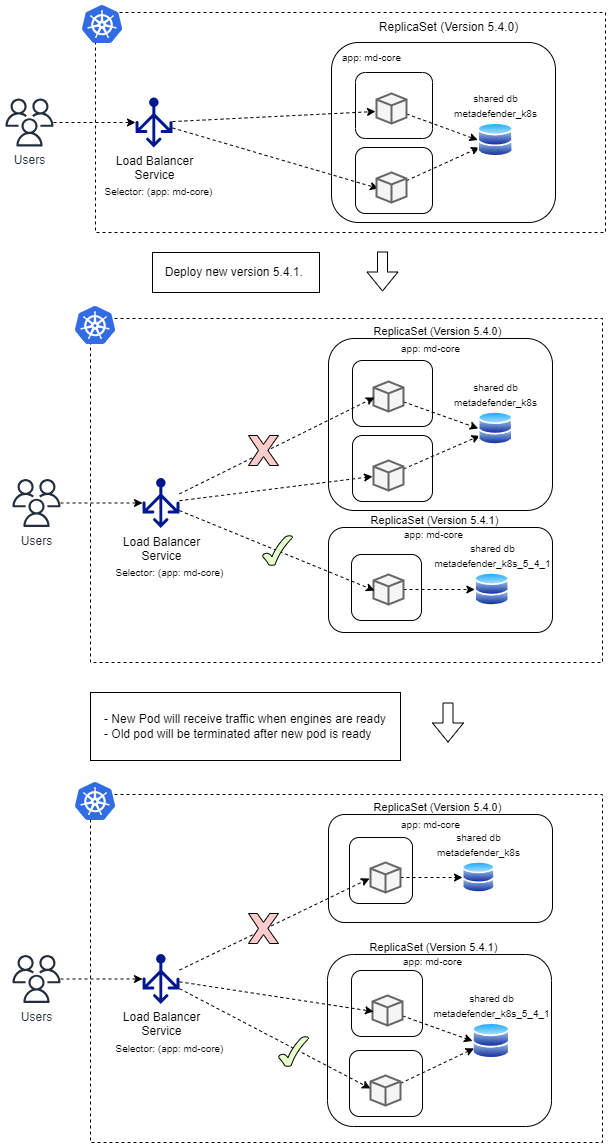For upgrading MetaDefender Core the container of the application contains the automation to upgrade the database schema and migrate the configuration data. There are 3 strategies that we would like to point out to use when upgrading it.
- Rolling Update ( Easy deployment where functionality test with new version is based on Kubernetes Probes )
- Blue-Green Deployment (2 or more activations licensed where is possible to test the new image before) - On RoadMap
- Blue-Green Deployment + Hot Backup ( When needed to go above the activations licensed ) - On RoadMap
Upgrading from one version to another on Kubernetes only support the migration of specific data.
- Workflow
- Healthcheck
- User Management
The data of the processing history is not supported to be migrated from one version to another
As indicated in Deploying on K8S , the Kubernetes probes like Readiness and Liveness probes help the application to control the expected behavior, not to have a downtime, when doing an upgrade.
RollingUpdate Strategy
When using the Rolling Update strategy provided by Kubernets technology, these are the main points to consider
- Traffic wont be sent to new pods until readiness probe is succesful
- Old version pods won’t be terminated until new version pods are ready to serve traffic
- Rolling Update is the default strategy for deployment

How to upgrade using RollingUpdate
When using the RollingUpdate strategy, there are two more options that let you fine-tune the update process:
- maxSurge: The number of pods that can be created above the desired amount of pods during an update
- maxUnavailable: The number of pods that can be unavailable during the update process
Both maxSurge and maxUnavailable can be specified as either an integer (e.g. 2) or a percentage (e.g. 50%), and they cannot both be zero
If requests are being sent they can end up hitting two different version pods meaning two different databases.
Step by step using kubectl
- Set Up the environment variables for the pod to know that will need to migrate the information to new database
kubectl create configmap mdcore-config -n <namespace> --from-literal=MDCORE_UPGRADE_FROM_DB_NAME=<CURRENT_DB_NAME> --from-literal=UPGRADE_DB=true -o yaml --dry-run=client | kubectl apply -f -- Set new image version on the MetaDefender Core deployment
kubectl set image -n <namespace> deployments/md-core md-core=opswat/metadefendercore-debian:<NEW_IMAGE_TAG>Step by step using helm
- Set new image version in values.yaml helm file
env MDCORE_UPGRADE_FROM_DB_NAME<CURRENT_DB_NAME> UPGRADE_DBtrue core_components md-core imageopswat/metadefendercore-debian<NEW_IMAGE_TAG>- Run helm upgrade command with the environment variables desired if not indicated in values.yaml file when first deployment
helm upgrade mdcore mdcore/ --namespace <Namespace> -f <Additional_yaml_file> \ --set core_ingress.enabled=$ingress_enabled \ --set mdcore_license_key=<MDCORE_LICENSE_KEY> \ --set deploy_with_core_db=<boolean_k8s_db_running_pod> \ --set core_components.md-core.replicas=<replicas> \ --set mdcore_password=<mdcore_password> \ --set mdcore_user=<mdcore_user> \ --set db_user=<db_user> \ --set db_password=<db_password> \ --set MDCORE_DB_HOST=<db_host>Rollout Failed Update
kubectl rollout undo deployments/md-core -n <namespace>How to upgrade with API Export/Import Configuration (Old-Fashioned way)
The steps needed to follow are:
1. Export the current configuration, like user management, worflows or settings configured. For it is needed to use the API endpoint Export Configuration (New version)
curl --request GET \ --url 'http://localhost:8008/admin/export/v2' \ --header 'apikey: {apikey}' \ --header 'password: {password}' --output <filename>.zip2. Adapt helm configuration to upgrade to the new image version
- In case of controlling all the data from your values.yaml file, be sure that the maxUnavailable and maxSurge attributes of the deployment strategy is adapted to your deployment use case and the image version is changed to the new one
md-core namemd-core imageopswat/metadefendercore-debian<new_core_version> #Change <new_core_version> with any tag in Docke Hub #.... #.... #.... strategy#Example for use case when having more than 1 pod running typeRollingUpdate rollingUpdate maxSurge0 maxUnavailable1helm upgrade mdcore mdcore/ -f <external_file_for_csp.yaml> \ --set env.UPGRADE_DB=true \ --set env.RETRY_UPGRADE=5- In case of controlling attributes from the helm install command, be sure that the maxUnavailable and maxSurge attributes of the deployment strategy is adapted to your deployment use case and the image version is changed to the new one
helm upgrade mdcore mdcore/ -f <external_file_for_csp.yaml> \ --set core_ingress.enabled=<ingress_boolean> \ --set mdcore_license_key=<MD_Core_Lincese_Key> \ --set deploy_with_core_db=<Postgres_Pod_Boolean> \ --set core_components.md-core.replicas=<Number_of_replicas_Core> \ --set db_user=<DB_USER> \ --set db_password=<DB_PWD> \ --set MDCORE_DB_HOST=<DB_HOST> \ --set core_components.md-core.image="opswat/metadefendercore-debian:<Image_Version_TAG>" \ --set core_components.md-core.strategy.rollingUpdate.maxUnavailable=1 \ --set core_components.md-core.strategy.rollingUpdate.maxSurge=0 \ --set env.UPGRADE_DB=true \ --set env.RETRY_UPGRADE=53. Import the configuration exported in the step 1 For it is needed to use the API endpoint Import Configuration (New version) . See how to use it in the example below.
curl --request POST \ --url 'http://localhost:8008/admin/import/v2' \ --header 'Content-Type: application/octet-stream' \ --header 'apikey: {apikey}' \ --header 'password: {password}' \ --data-binary '@<file_name>.zip'
